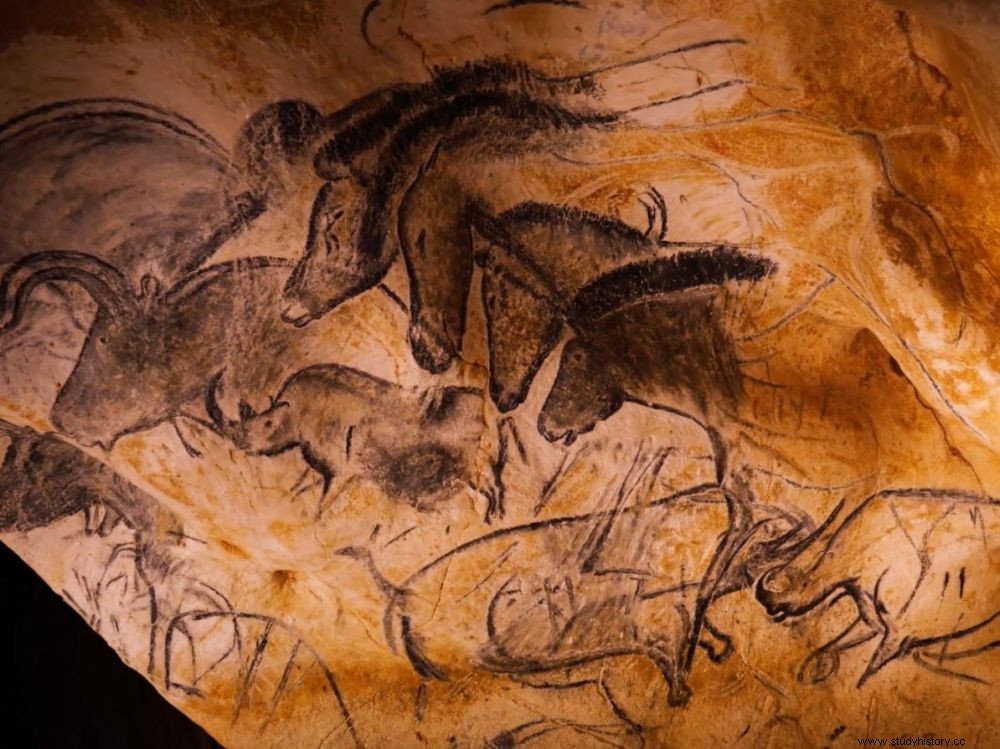Flint, drugs and rock'n roll:life in the Palaeolithic was much more exciting than you might imagine! Focus on the cave paintings of the Chauvet cave and the vision they give us of these paleoartists, in a documentary by Sciences et Avenir .

The Chauvet cave is a whole bestiary:lions, bears, aurochs, horses, megaloceros, woolly rhinoceros and even an owl!
.dysaidehighlight{background-color:#ffce71!important;color:#f51616!important}
.dysaidehighlight{background-color:#ffce71!important;color:#f51616!important}
Forget chestnuts and Picodon:the real treasure of the Ardèche dates back to the Palaeolithic period! In its limestone bug, the Chauvet cave is a real relic of a time that those less than 30,000 years old cannot know. Its function, at the time, was perhaps ritual. "Very few objects were found there on the ground, it is not a cave that the Aurignacians inhabited , analyzes the prehistorian Nicolas Teyssandier, author of the book Our First Times (2019, ed. The City Burns). It's probably an unusual place, even for them."
An extraordinary place - occupied during two periods, around -30,000 then -26,000 years ago - including Sciences et Avenir was able to visit the replica (and exceptionally film it):the Grotte Chauvet 2 - the original being closed to the public. In our documentary to discover below, Nicolas Teyssandier also notes the presence of a very particular bestiary, which smells of the Ice Age:lions, bears, aurochs, horses, megaloceros, woolly rhinoceros and even an owl! For François Djindjian, Professor of Archeology at the University of Paris 1 Panthéon Sorbonne, these associations of species are linked to the territories. At Chauvet, as well as at other contemporary sites in Western and Central Europe, these bestiaries "highlight the movements of human groups coming from the upper valley of the Danube towards the West (Rhine towards Belgium; Doubs towards the Saône basin, Rhône towards the south) until about -25,000 years ago, when the climatic deterioration cuts this communication channel ", he wrote in a study in 2010.
Forget chestnuts and Picodon:the real treasure of the Ardèche dates back to the Palaeolithic period! In its limestone bug, the Chauvet cave is a real relic of a time that those less than 30,000 years old cannot know. Its function, at the time, was perhaps ritual. "Very few objects were found there on the ground, it is not a cave that the Aurignacians inhabited , analyzes the prehistorian Nicolas Teyssandier, author of the book Our First Times (2019, ed. The City Burns). It's probably an unusual place, even for them."
An extraordinary place - occupied during two periods, around -30,000 then -26,000 years ago - including Sciences et Avenir was able to visit the replica (and exceptionally film it):the Grotte Chauvet 2 - the original being closed to the public. In our documentary to discover below, Nicolas Teyssandier also notes the presence of a very particular bestiary, which smells of the Ice Age:lions, bears, aurochs, horses, megaloceros, woolly rhinoceros and even an owl! For François Djindjian, Professor of Archeology at the University of Paris 1 Panthéon Sorbonne, these associations of species are linked to the territories. At Chauvet, as well as at other contemporary sites in Western and Central Europe, these bestiaries "highlight the movements of human groups coming from the upper valley of the Danube towards the West (Rhine towards Belgium; Doubs towards the Saône basin, Rhône towards the south) until about -25,000 years ago, when the climatic deterioration cuts this communication channel ", he wrote in a study in 2010.
In all, the decorated cave presents more than 500 representations engraved on the walls of the loose rock, traced in charcoal or ocher, blown, blurred, outlined or stamped. "It is precisely this diversity of techniques used that makes the cave famous , underlines the popularizer and archaeologist by training Clothilde Chamussy, co-author of the book Retour vers le Paléo (2019, ed. Flammarion). The Cave Chauvet completely upset the idea that we had in the 1990s of prehistoric art, which was considered childish art, as if it were the childhood of humanity ."
"Cinematograph ancestor"
"Animals are most often represented in motion with, sometimes, an impression of perspective ", describe the authors of the Hominids reference site. On huge panels at the back of the cave, the paleoartists multiply the juxtapositions of drawings of the same animal, as if to suggest its movement. An "original form of narration graph "for specialist archaeologist Marc Azéma, whom he even describes in a study as the ancestor of cinematography.
Filmmakers, our ancestors? Punks, anyway! They might have tried drugs before the invention of rock'n roll:"To obtain this faded effect that you see in places on cave paintings, one of the techniques known as spitting consists of working the pigment into the mouth with his saliva before projecting it on the wall “, explains in our documentary the archaeologist Jennifer Kerner (Paris Nanterre University) and co-author of Retour vers le Paléo . But here it is:some of the pigments used, such as manganese, turn out to be powerful hallucinogenic neurodisruptors. "Besides, in some caves [but not at Chauvet, editor's note] representations of bizarre animals or half-human half-animal hybrids:some researchers believe that the authors of the paintings could have poisoned themselves with manganese and tried to represent these hallucinations on cave walls “, continues the researcher. The rest to discover in our video above!
